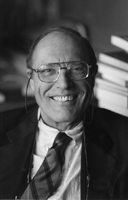Obituaries: Gian-Carlo Rota
June 23, 1999

Gian-Carlo Rota, 1932-1999
Rota was born in Vigevano, Italy, on April 27, 1932. Forced to flee Mussolini's death squads, his family left Italy in 1945, after which they lived for a time in Ecuador. His sister, Ester Rota Gasperoni, recounted the family's escape from Italy in two books, Orage sur le Lac and L'arbre des Capulies. Rota came to the United States in 1950; he received a BA from Princeton University and, in 1956, a PhD from Yale University under Jacob T. Schwartz.
He held postdoctoral positions at the Courant Institute and Harvard University before arriving at MIT in 1959. Except for a short hiatus at Rockefeller University (1965-67), he remained at MIT until his death, much to the good fortune of countless MIT undergraduates, graduate students, visitors, and faculty who were able to share his enthusiasm and joy for mathematics, philosophy, and life in general.
This brief chronicle of events, of course, in no way conveys what the man was really like. Being associated with Gianco meant far more than mathematical discussions and lectures. He became an important part of the personal lives of his friends and colleagues. He took a genuine interest in the well-being of all his associates and made many selfless sacrifices of time, money, and intellectual effort on their behalf. It almost goes without saying that this altruism, together with his beautifully prepared and delivered lectures, made him one of the most popular and respected teachers at MIT.
Rota had far-ranging mathematical interests, but his first love (developed after he had received his doctorate in functional analysis) was combinatorics. He intuitively realized that combinatorics, which in the early 1960s was not considered a "serious" subject and was regarded with disdain by most leading mathematicians, had tremendous potential to develop into a mature and important area that would enrich many other seemingly unrelated parts of mathematics. Intuitive understanding of this type was characteristic of Rota's work---he was always looking for the "big picture" and trying to understand the true essence of any subject in which he was interested.
A seminal development for the future of combinatorics was the Foundations, a series of papers inaugurated by Rota with his now famous "On the Foundations of Combinatorial Theory I. Theory of M�bius Functions" (Z. Wahrscheinlichkeitstheorie 2 (1964), 340-368). This paper immediately captured the imagination of many young mathematicians (including myself) and planted the seeds for many subsequent developments within combinatorics, such as the theory of topological combinatorics and the tremendous expansion of matroid theory. Rota followed up the "Foundations I" paper with over 80 further papers in combinatorics (to say nothing of papers, essays, and reviews in many other areas of mathematics and in philosophy) that established him as the founding father and leading guru of the new subject of algebraic combinatorics.
An important watershed in the development of combinatorics was the NSF Advanced Science Seminar in Combinatorial Theory at Bowdoin College during the summer of 1971. Gian-Carlo presided over this meeting as a godfather of the "new combinatorics." He was involved in all aspects of the eight-week meeting, from the mathematical content to social activities. I recall one pedagogical innovation of his---the tandem lecture. He would choose about six people from the audience who had to leave the room and not talk to each other. He would then call them into the lecture hall one at a time to deliver a five-minute lecture. Each lecture had to be a continuation of the previous lecture, based on what the previous speaker had left on the blackboard.
There were many other facets of Rota's complex personality that I can only hint at here. He was deeply interested in phenomenology and wrote many papers and essays in this area. Although English was not his native language, he achieved a mastery of it that far surpassed the best efforts of most native speakers. He wrote innumerable completely honest and lucid essays on mathematicians and the practice of mathematics, many of them collected into the books Discrete Thoughts and Indiscrete Thoughts. He was working on a book of provocative quotations entitled Forbidden Thoughts at the time of his death.
Rota developed Advances in Mathematics virtually single-handedly into one of the leading journals of research mathematics, and he was the editor-in-chief of the Encyclopedia of Mathematics, a book series that contains definitive expositions of a wide range of mathematical topics. In the course of his career, he held visiting positions at ten universities throughout the world, and, beginning in 1966, he was a consultant at Los Alamos National Laboratory. He received four honorary degrees (and was just about to receive another, from Nankai University); also among his honors are the Steele Prize of the American Mathematical Society (1988) and the Killian Faculty Achievement Award at MIT (1996). He was appointed the Norbert Wiener Professor of Mathematics at MIT for a five-year period beginning in 1998, and he was the Colloquium Lecturer of the American Mathematical Society in 1998.
Gianco had the extraordinary ability to touch deeply the lives of all with whom he associated, whatever their background and experience. Rarely, if ever, has the passing of a professional mathematician left such a large void.
Richard Stanley, Department of Mathematics, MIT.

